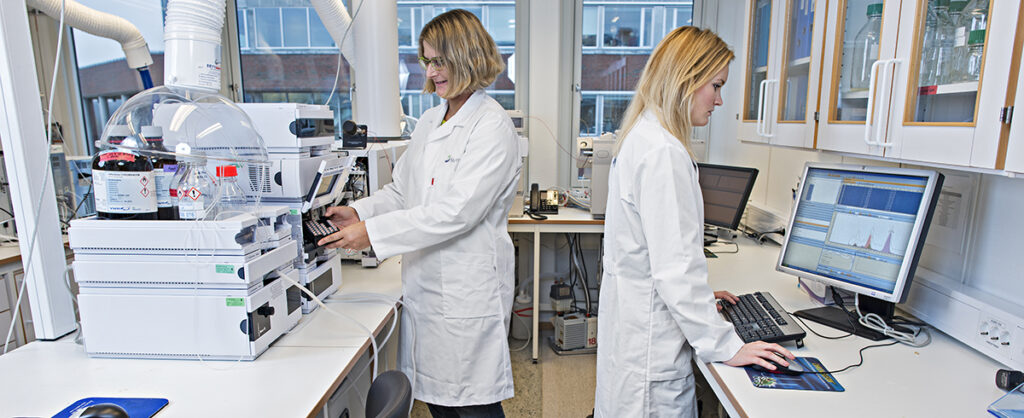FutureFoodControl
Food safety, reduced food waste and sustainable packaging

New challenges are constantly emerging related to microbial security and deterioration of food. At the same time, it is important to reduce both food waste and the use of plastic for food packaging.
Start
01. Jan 2021
End
31. Dec 2024
Funded by
The Fund for Research Fees for Agricultural Products (FFL)
Project Manager(s):
Cathrine Kure Finne
Solveig Langsrud
Even Heir
Anlaug Ådland Hansen
Birgitte Moen
Øydis Ueland
Other Participants:
Laura García Calvo
Annette Fagerlund
Agnete Jordhøy Lindstad
Anette Wold Åsli
Charlotte Kummen
Dongfang Li
Ellen F. Mosleth
Elin Merete Wetterhus
Hilde Haver
Hanne Larsen
Ingunn Berget
Ida-Helene Kågen Spydevold
Ingrid Måge
Ida Rud
Jawad Sarfraz
John-Erik Haugen
Josefine Skaret
Karen Wahlstrøm Sanden
Lene Øverby
Magnhild Seim Grøvlen
Marit Kvalvåg Pettersen
Merete Rusås Jensen
Nusrat Sharmin
Shiori Koga
Tom Christen Johannessen
Tove Maugesten
Trond Møretrø
Vibeke Høst
Valérie Lengard Almli
The primary goal of this strategic program is increased knowledge to achieve safe food, reduced food waste and sustainable packaging.
Secondary objectives
- Increased knowledge on microbial contamination and measures for control of microorganisms in food and environments
- Increased knowledge and development of sustainable packaging systems
- Increased knowledge of consumer attitudes and behaviour in a food safety-, packaging and food waste perspective
The program focus on research that meet challenges in the Norwegian Food sector and the UN sustainable goal.
Results so far
Breaking the chain of microbial infection in food environments
Persistent L. monocytogenes is a common challenge for food processing plants. The nutrient composition together with low temperature (3 °C) and the in-house bacterial flora, may explain that L. monocytogenes did not establish in a fresh produce processing facility. Furthermore, it was found that rocket salad contain antilisterial components.Concerns about transfer of antibiotic resistance genes from environmental bacteria to pathogens has been raised. Characterisation and whole genome sequencing of a collection of Pseudomonas spp from the Norwegian chicken production chain indicated, however that these common food bacteria, which are naturally resistant to many antibiotics, do not carry resistance determinants that are disseminated to pathogens.
The use of technologies, processes and ingredients can provide increased control of microorganisms in food and thus contribute to increased shelf life, improved food safety and reduced food waste. A scientific paper under revision shows how lactic acid and fermentates in combination with MAP packaging can be used to achieve raw chicken with longer microbiological shelf life and improved sensory quality. Work is continuing on microbial spoilage and quality of chicken and on new microbial control strategies on risk food products, including the use of bacteriophages against pathogens A new equipment (“Pulsed Electric Field”) with a potentially wide range of applications in food processing and microbiological control has been installed in Nofima’s process hall. Training is required before the equipment can be used.
We have focused on expanding our in-house MALDI-TOF MS database of food related microorganisms as well as using methods for analysis beyond identification. Optimization of methods for cloning, expression and purification of growth factors has been performed. Produced growth factors have been functionally tested in collaboration with Precision food production.
Sustainable packaging solutions
Results on packaging of chicken fillets have shown that biodegradable packaging material (PLA) and active packaging can maintain the quality and have the potential to replace the traditional packaging materials, such as APET/PE trays. Another study shows that increasing number of or the capacity of liquid absorbent pads in package of chicken fillets leads to significant increase in drip loss during refrigerated storage, more pronounced for 60% CO2/40% N2 compared to 75%O2/25% CO2, and a lower gas/product volume ratio can also result in increased liquid loss.
Breaking the chain of microbial infection in food environments
We will source tracking of pathogens, spoilage bacteria and fungi in the production facilities, monitoring and effective corrective actions. We will focus on control of microbes in risk foods.
This work will include characterization of specific spoilage bacteria and their spoilage potential in products (raw chicken), determine the effect of mild preservation technologies on risk organisms (spoilers, pathogens) in raw chicken and perishable, plant-based foods, and focus on prevalence and dissemination potential of antimicrobial resistance genes in Listeria monocytogenes and prevalent bacterial spoilers from food and environmental origin in Norway.
Sustainable packaging solutions
We will evaluate packaging systems and storage conditions by use of recycled or renewable packaging materials without compromising safety, shelf life or negative impact on food waste.
We will explore the potential of renewable/recycled materials for application in packaging of fresh products, and determine the effect of active and intelligent packaging solutions on the shelf life of selected food packaging of fresh products, and determine the effect of active and intelligent packaging solutions on the shelf life of selected food products when applied in combination with biobased/biodegradable materials.
Food safety and consumer perceptions
We will strengthen the molecular methods for research on microbial composition, tracking and traits in food processing environments, in food and during food storage. The platform will serve other part of the project as well as the parallel programs “SusHealth” and “Precision food production”.
We will focusing on consumer aspects related to food safety, food waste and packaging, in collaboration with the parallel “FoodForFuture” program. WP6 coordinates activities related to user involvement, dissemination of results and program management.
Publications

Strategic research program
This is one of four strategic research programs funded by The Fund for Research Fees for Agricultural Products (FFL) in the period 2021-2025.
The programs:
FoodForFuture | FutureFoodControl | SusHealth | Precision
Similar projects